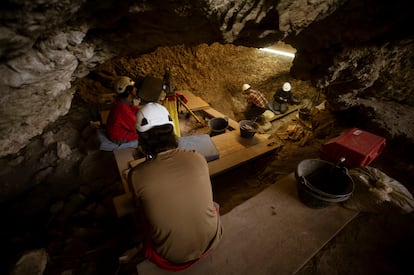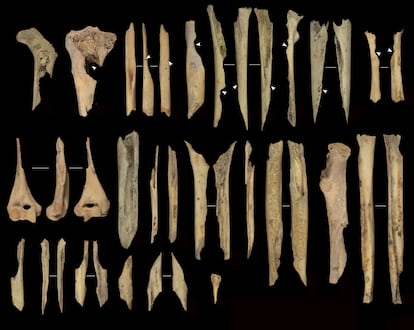Skinned, quartered, and eaten by rival tribes: traces of cannibalism found in Atapuerca 5,500 years ago

A group of archaeologists has discovered hundreds of human remains dating back more than 5,000 years in a cave on the southern slopes of Atapuerca (Burgos). This would hardly be surprising, given that the Burgos mountain range is the most important European site for the study of human prehistory . But in this case, the bones show signs of "anthropogenic modifications," as their discoverers call them. These changes are nothing more than signs of having been dismembered, skinned, eviscerated, roasted, and/or cooked and eaten. This cannibalistic event, detailed as if it were a forensic report in the journal Scientific Reports , was not due, according to its authors, to hunger or a ritual act of appropriating the essence of the devoured, but rather an act of violence against a rival neighboring group seeking its "metaphysical elimination," in the words of one of the scientists.
"Throughout prehistory, what we find are professional butchers," says Palmira Saladié, a researcher at the Catalan Institute of Human Paleoecology and Social Evolution (IPHES-CERCA) and first author of the study. "In this case, humans process food just as they process animals, and they process them intensively and consume them intensively as well," she adds.
The discovery was made during excavations in a section of El Mirador Cave, used for millennia as a sheepfold for flocks of goats and sheep. Curiously, it ceased to be used for that purpose shortly after this act of cannibalism. Of the more than 600 bones they found, at least 239 had more than one of these anthropogenic modifications. Putting the different bones together to determine how many were eaten and when was not easy. The shepherds must have periodically removed the manure and burned it, thereby removing the human remains. Even so, they were able to reconstruct eleven bodies. They estimated the approximate age at which nine of them died. Half were young or children, while the rest were adults.
Using carbon-14 dating, they were also able to determine when they were eaten. It was between 5,709 and 5,573 years ago. Despite the time span and the fact that the bones were scattered throughout the cave, "it was a single event and also occurred over a very short period of time, probably just a few days," maintains Saladié, whose team specializes in the archaeology of cannibalism.

Most of the bones (222) showed signs of having been burned (see image above). The researchers clarify that many of them may have acquired that tanned color during the burning of the dung. That's why they looked for other concomitant marks, such as cuts in the bones made with stone tools (the Metal Age was still centuries away) or other marks. And they weren't looking for just any cut in the bone, but rather for signs of having passed through the hands of an experienced butcher, such as gutting or skinning.
Antonio Rodríguez, a researcher now at the Mérida Archaeology Institute (IAM, CSIC-Junta de Extremadura) and co-author of this study, a kind of forensic science applied to cannibalism: “Stone or metal tools—in this case, we only have stone ones from the Neolithic—generate very characteristic marks when they touch bone. From a microscopic perspective, they have a series of details that differentiate them from other types of marks.”
The location of the cut is also key. "For example, evisceration marks are always cut marks on the inside of the ribs, because that's where the viscera are, both the upper ones (lungs, heart) and the lower ones," says Rodríguez, who was researching at the IPHES (Spanish Institute of Archaeology and Natural History) when this study was conducted. "However, if we find marks on the outside of the ribs, and especially on the proximal part, toward the thoracic vertebrae, in the back, that means they've removed the muscle corresponding to the loin, which would be the loins," explains the archaeologist.
The work is further refined, obtaining a wealth of information from the two subsequent processes: cooking and, finally, eating. In addition to the roasts, the condition of many bones indicates that some parts were cooked. "What cooking does is accelerate the process that would later occur naturally, resulting in the loss of organic matter, especially collagen and water," Saladié recalls. This makes the bones more crystalline, more transparent, and with a more polished surface. "Although it's somewhat subjective, when the entire group follows the same pattern, it allows you to relate it to cooking," he adds.

Finally, many of the bones showed dents, marks left by human teeth. Others, the smaller ones, like those from the hands, had been chewed or broken, as if they were from a chicken or rabbit. And several of the flatter, more elongated bones showed signs of having been bent until they broke. "It's a very characteristic modification of human activity, because you normally need both hands. It creates that peeling that resembles what happens when a branch breaks," Rodríguez says.
Thanks to the unique ratio of two strontium isotopes (versions of the same chemical element), researchers were able to determine that the cannibalized individuals were neighbors of the cannibals and had not come from outside. Saladié explains: “Strontium leaves clear signals through the food we consume, especially water, in bones and teeth, allowing us to create global strontium maps and link an individual to their origin.”
Knowing so much about those eaten, Saladié and his colleagues know almost nothing about those who ate them. Rodríguez explains this again: “This is the most common; what we usually find when we're dealing with cannibalistic assemblages is the cannibalized individuals. But the evidence of who the commensals are is much more difficult to interpret, because what we find is basically household garbage. And if what's in it are the remains of other people you've eaten, then you find the eaten individuals, but we don't know exactly who the commensals are.”
Nor do they know why they were eaten. Here they acknowledge that they are entering the realm of speculation, albeit supported by convincing elements, such as comparative ethnography. Since cannibalism is a practice almost as old as the genus Homo itself , they could have been eaten out of hunger. As the case of the Uruguayan rugby players in Viven recalls, humans sometimes eat other humans out of necessity. But the authors of the discovery used environmental indicators, such as wood and pollen analysis, to rule out the possibility that, despite the region becoming arid at the time, it was characterized by a Mediterranean climate and vegetation ideal for livestock farming and the nascent agriculture.
Another possibility is that it was a ritual cannibalism, one in which the diners eat another, usually relatives (endocannibalism), as a means of acquiring their powers, abilities, soul... But these cases usually occur in the context of a cultural tradition, with events that occur over time and not isolated ones like this one.
“This was not a funerary tradition nor a response to extreme famine,” explains Francesc Marginedas, also from IPHES, in a press release. “The evidence points to a violent episode, given the speed with which it developed, possibly the result of a conflict between neighboring farming communities,” he adds. In fact, the authors link the event to other cases of extreme violence elsewhere in Europe around the same time. Rodríguez, his colleague from IAM, adds a dichotomy that exists in this type of cannibalism: On the one hand, there is “the physical elimination of the enemy, which is achieved by killing it, and the metaphysical elimination of the enemy, which is achieved by consuming it because it is reduced to feces; but sometimes there is also the absorption of that enemy's characteristics.”
EL PAÍS





